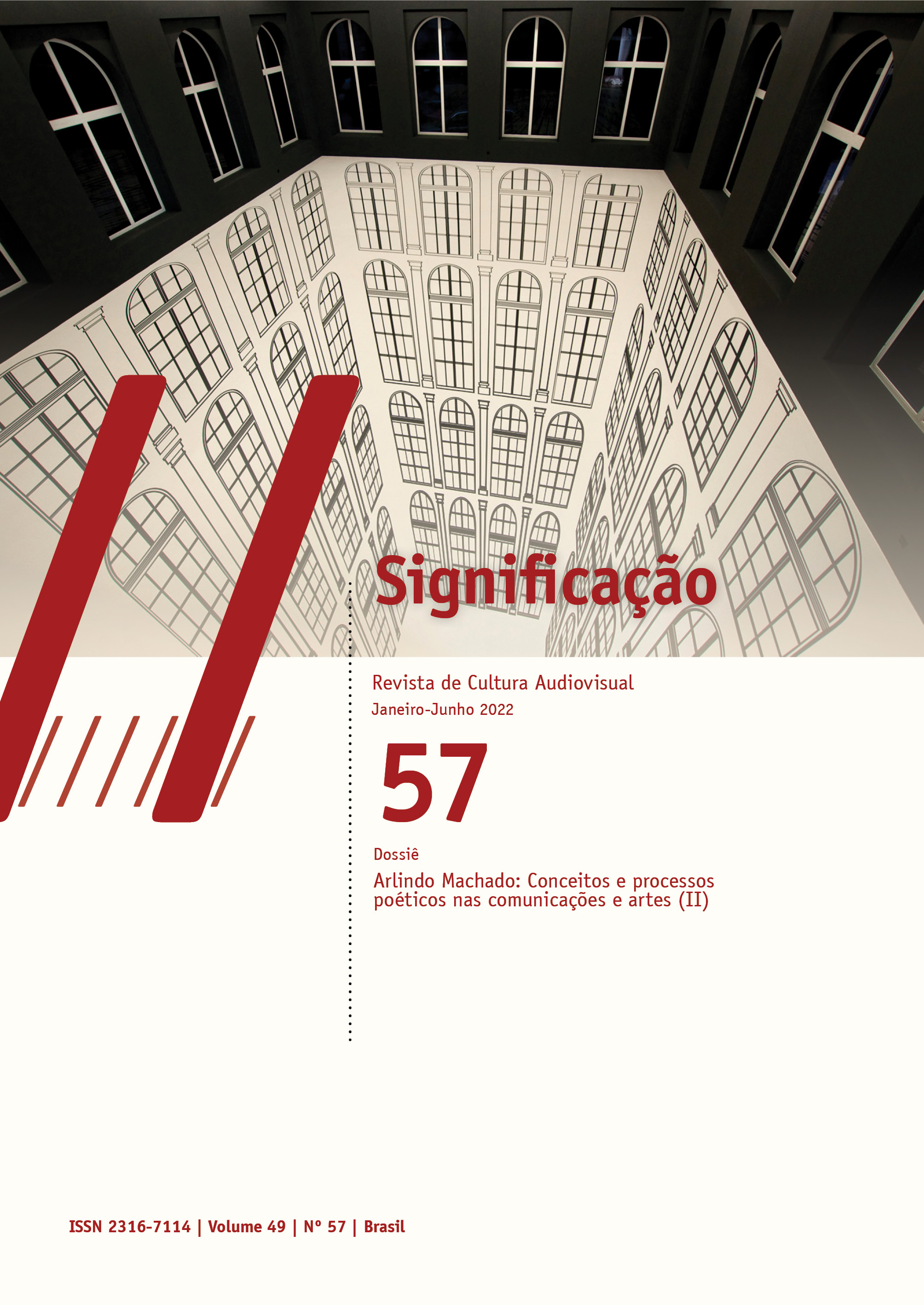Interiors: Wavelength (1967) and The living room (2000), by Michael Snow
DOI:
https://doi.org/10.11606/issn.2316-7114.sig.2022.184312Keywords:
Michael Snow, Experimental cinema, Comparative analysisAbstract
The article proposes an analysis of Michael Snow’s The living room (2000), made during a period when the filmmaker used digital technologies in an experimental and playful way. The analysis will be made by means of comparisons with previous works by Snow, especially Wavelength (1967), a landmark in structural cinema, and with works by other filmmakers (Georges Méliès and Alfred Hitchcock), as well as by visual artists from different medias, such as painting and collage. Our hypothesis is that Snow’s films represent a contemporary scopic regime that might be called, following Pascal Bonitzer, “telescopic perspective”. We hope to demonstrate that the filmmaker’s work goes beyond the frame of reference usually attributed to it, including in its genealogy the crisis of perceptual experience already in place since the visual modernity of the 19th century.
Downloads
References
AUMONT, J. Le montreur d’ombre. Paris: Vrin, 2012.
BAUDRY, J.-L. “Cinema: efeitos ideológicos produzidos pelo aparelho de base”. In: XAVIER, I. (org.). A experiência do cinema. Rio de Janeiro: Graal, 1983. p. 383-399.
BAZIN, A. O cinema: ensaios. São Paulo: Brasiliense, 1991.
BONITZER, P. Le champ aveugle: essais sur le cinéma. Paris: Gallimard, 1982.
BONITZER, P. Décadrages: peinture et cinéma. Paris: Editions de l’Etoile, 1987.
CALLOU, H. A. “A decomposição do tempo: as origens da duração no cinema experimental”. In: ENCONTRO ANUAL DA COMPÓS, 28., 2019, São Paulo. Anais […]. São Paulo, Compós, 2019.
CHABROL, C.; ROHMER, E. Hitchcock. Paris: Ramsay, 2011.
DUARTE, T. “O cinema estrutural norte-americano (1965-1972): sobre os debates em torno do termo”. In: DUARTE, T.; MOURÃO, P. (org.). Cinema estrutural. Rio de Janeiro: Aroeira, 2015. p. 42-61.
DUBOIS, P. O ato fotográfico. 14. ed. Campinas: Papirus, 2012.
FLEISCHER, A. “La cinémachine de Michael Snow”. In: DAMISCH, H. et al. Michael Snow: Panoramique. Bruxelles: Cinémathèque Royale de Belgique, 1999.
FOUCAULT, M. As palavras e as coisas. 9. ed. São Paulo: Martins Fontes, 2007.
GAUDREAULT, A. “Theatricality, narrativity, and trickality: reevaluating the cinema of Georges Méliès”. Journal of Popular Film and Television, Marquette, v. 15, n. 3, p. 110-119, 1987.
GUNNING, T. “‘Nothing will have taken place – except place’: the unsettling nature of camera movement”. In: SÆTHER, S. Ø.; BULL, S. T. (org.). Screen space reconfigured. Amsterdam: Amsterdam University Press, 2020. p. 263-280.
MICHELSON, A. “About Snow”. October, Cambridge, n. 8, p. 111-125, 1979.
MICHELSON, A. “Toward Snow”. In: SITNEY, P. A. (org.). The avant-garde film: a reader of theory and criticism. New York: New York University Press, 1978.
NOGUEZ, D. “Sur la longueur d'onde de Michael Snow”. In: SAYAG, A. (org.). Michael Snow. Paris: Centre Pompidou, 1978.
PANOFSKY, E. Perspective as symbolic form. New York: Zone Books, 1991.
PENLEY, C. The future of an illusion: film, feminism, and psychoanalysis. Minneapolis: University of Minnesota Press, 1989.
POGGI, C. “Frames of reference: “table” and “tableau” in Picasso’s collages and constructions”. Art Journal, New York, v. 47, n. 4, p. 311-322, 1988.
SITNEY, P. A. “Structural film”. Film Culture, New York, n. 47, p. 1-10, 1969.
SITNEY, P. A. “O cinema estrutural”. In: DUARTE, T.; MOURÃO, P. (org.). Cinema estrutural. Rio de Janeiro: Aroeira, 2015. p. 10-38.
SITNEY, P. A. Visionary film: the American avant-garde: 1943-1978. 2. ed. Nova York: Oxford University Press, 1979.
SNOW, M. “Notes sur Wavelength pour le festival du film expérimental de Knokke-le-Zoute (1968)”. In: SNOW, M. Des écrits: 1958-2001. Paris: Centre Pompidou, 2002.
TURVEY, M. “The child in the machine: on the use of CGI in Michael Snow’s *Corpus Callosum”. October, Cambridge, n. 114, p. 29-42, 2005.
WEES, W. C. “Prophecy, memory and the zoom: Michael Snow’s Wavelength re-viewed”. Ciné-Tracts, Montreal, n. 14-15, p. 78-83, 1981.
Referências audiovisuais
NOTORIOUS (Interlúdio). Alfred Hitchcock, Estados Unidos da América, 1946.
SSHTOORRTY (Sshtoorrty). Michael Snow, Canadá, 2005.
THE living room (A sala de estar). Michael Snow, Canadá, 2000.
WAVELENGTH (Comprimento de onda). Michael Snow, Estados Unidos da América-Canadá, 1967.
Downloads
Published
Issue
Section
License
Copyright (c) 2022 Luiz Carlos Oliveira Junior

This work is licensed under a Creative Commons Attribution-NonCommercial 4.0 International License.
Authors who publish in this journal must agree with the following terms:
- Authors keep their copyrights and grant the journal first time publication rights, having their articles simultaneously licensed under the Creative Commons Attribution License, which allows sharing texts with authorship recognition and first publication on this journal for non-commercial purposes.
- Authors are allowed to make additional contracts, for a non-exclusive distribution of the article’s version published on this journal (e.g.: publishing in institutional repositories of articles or as a book chapter), with authorship recognition and first publication on this journal.
















